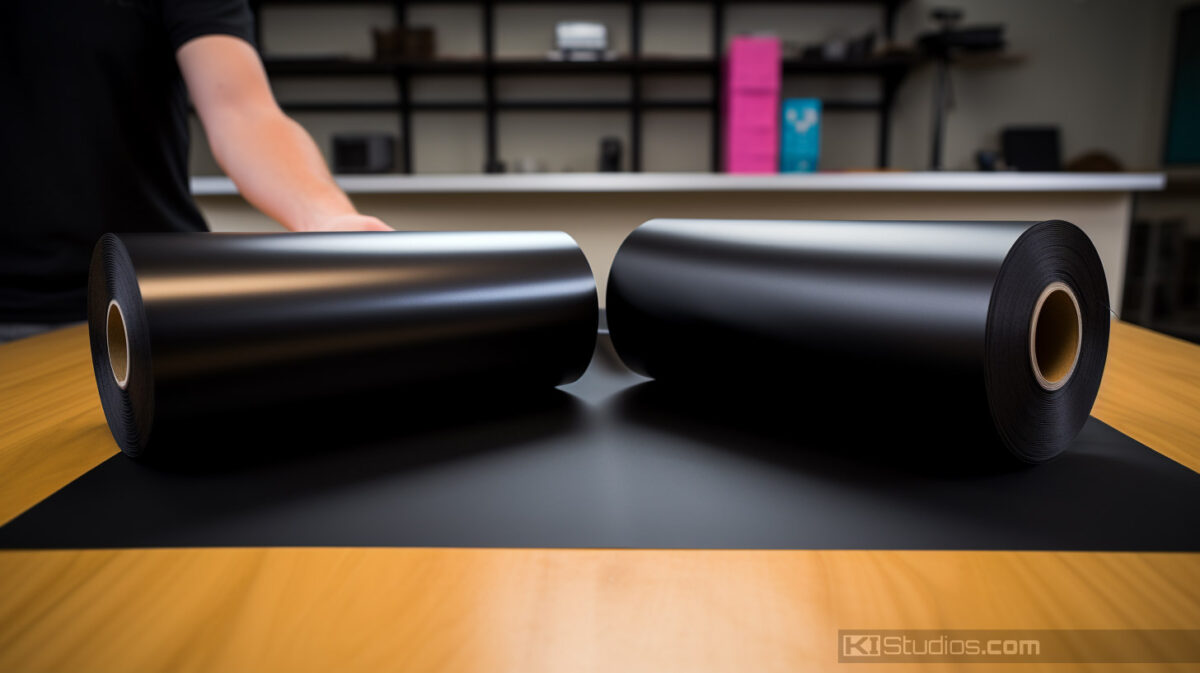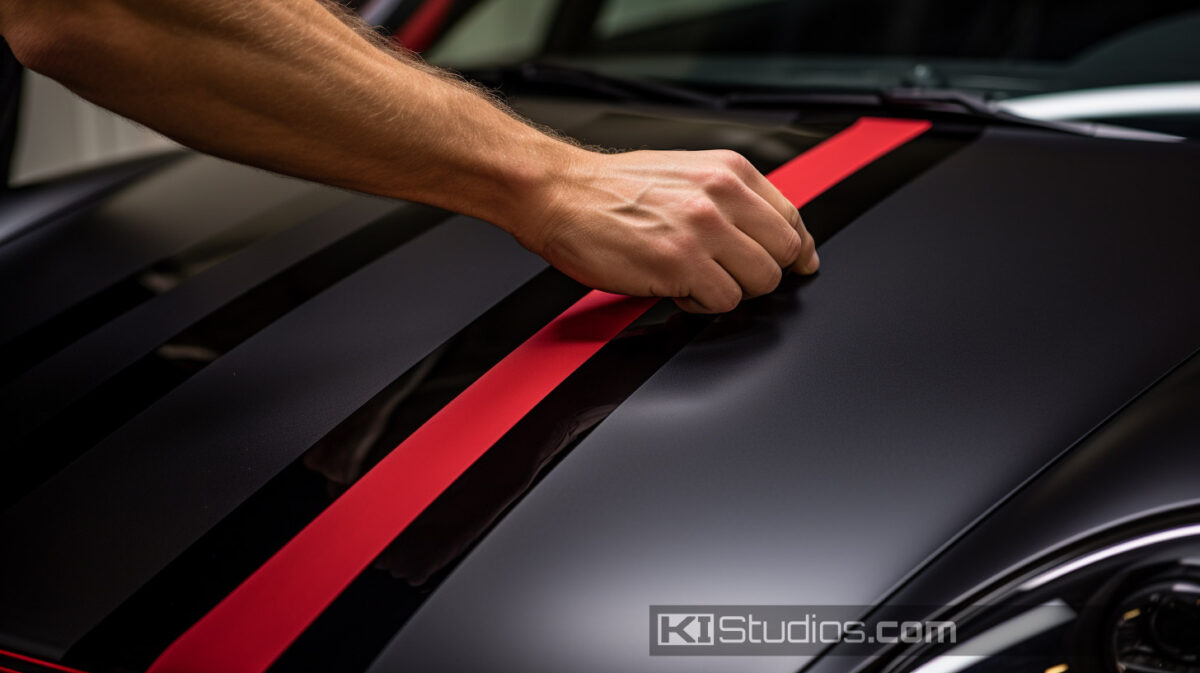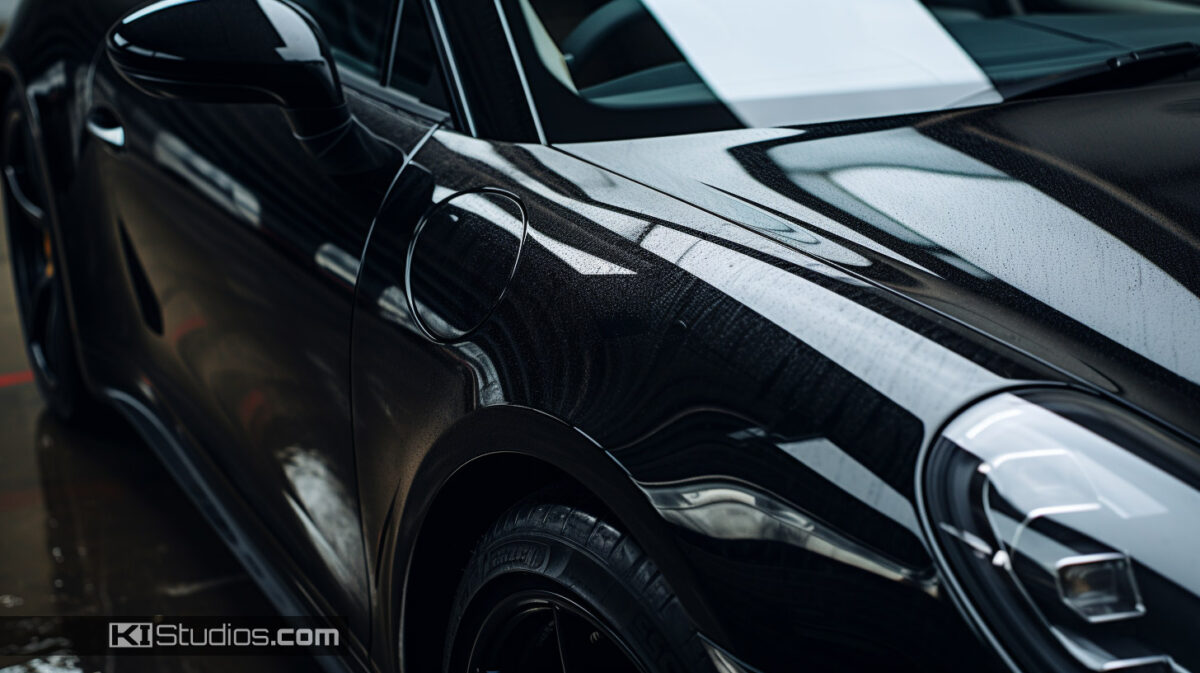So, you are looking for some vinyl stripes for your Porsche or Ferrari. You have arrived at the source, seeking answers. What is the best vinyl for car decals? Lets get right to it: There isn’t one. But, there is a right choice for your specific needs. Lets dig in.
What vinyl do you use?
That depends on the project. Most installers have a preference or a favorite brand of vinyl, because they are used to installing that brand every day. In reality, every brand that makes a high quality vinyl, also makes a low quality vinyl to fit the budget of your project needs. Some brands also fall short in some areas. For example, 3M makes a great smooth looking matte black cast 7125 series vinyl. However, their gloss black cast vinyl in the same series is the worst excuse for a gloss black in the industry. Avery Dennison makes a beautiful shiny smooth gloss black cast vinyl, but their matte in the same series looks a bit too chalky in comparison.
There is no single best vinyl brand. We choose the best vinyl for your particular project needs. We use a variety of brands, and a combination of cut vinyl and wrap vinyl, depending on the color, and application of the graphics. We use only high performance CAST vinyl by 3M, Avery Dennison, and Orafol. Every manufacturer will have their own color sets, and there are different types of vinyl that fill different needs.
There are two primary ways to manufacture vinyl. The cast process, and the calendared process. There are also two different types of vinyl; air release wrap vinyl and wet application cut vinyl. Each manufacturer can produce all of these different types of vinyl. So going by the brand name alone is not enough.
What is wrap vinyl?
Wrap vinyl, such as 3M 1080 / 2080 wrap film series, or Avery Dennison SW900 Supreme Wrapping film are cast vinyls, with air release backings. Wrap vinyls are designed with a short term, repositionable adhesive and are thicker, so you can stretch them over full panels of a car. They are to be applied dry, as the air release grids on the adhesive side help channel out the air for a bubble free application. Printed wraps are digitally printed on white wrap vinyl, then laminated in clear for protection and your choice of finish.
Wrap vinyls are becoming increasingly popular due to their ease of application and the large variety of colors. You also don’t need to have any special equipment or design experience to purchase a roll of vinyl and start applying. But, wrap vinyl does not replace all vinyl.
Stripes or spot graphics produced with wrap vinyls are usually one solid piece, instead of cut out shapes, and don’t require a transfer tape to pre-space your graphics. There are only two situations I would recommend using a wrap vinyl in place of cut vinyl spot graphics, stripes, or decals. One reason is when your stripes are going over a curved surface that requires stretch. The other reason is when the color you want is only available in a wrap vinyl.
Benefits of wrap vinyl:
– Ease of application with an air release backing.
– Sold in 60” wide rolls.
– Stretchable for wrapping full vehicles or conforming to curved surfaces.
– Wide range of colors.
Cons of wrap vinyl:
– Short lifespan on cut graphics.
– Thicker / more likely to snag or peel an exposed edge.
– Shorter manufacturer durability rating and life expectancy.
– Not as capable of intricate or clean cut shapes.
– Textured backings cause tunneling and don’t roll / ship well with transfer tape for cut graphics.
– More expensive because it is only sold in 60” wide rolls.
What is cut vinyl?
Cut vinyl, sometimes called sign vinyl, plotter vinyl, or these days “normal vinyl”, is made for plotters, producing computer cut shapes like stripe kits, logos, lettering, and any sort of graphic that does not fully cover the panel of your vehicle. Cut vinyl such as 3M 7125, Avery Dennison SC950 and Orafol 751/951 are going to be more durable and have a far longer lifespan than cut graphics made from a wrap vinyl. Cut vinyl graphic edges stay flat, unlike exposed edges of wrap vinyl that tend to lift.
Since cut vinyl has a flat backing, with no air release channels, we recommend the wet application method. Using water, with a couple drops of baby shampoo will prevent the vinyl from sticking until you squeegee the water out.
The flat and thin form factor of a cast cut vinyl is ideal for precision plotter cuts, allows for stacking multiple layers of colors, is the most durable / longest lasting type of vinyl application, and is easier to remove than shorter lifespan vinyls.
Benefits of cut vinyl:
– Longer lifespan and durability ratings than wrap vinyls.
– Thinner by design, so edges stay flat and resists edge peel.
– Ideal for stacking multiple colors/
– Smooth backing allows for use of transfer tape for pre-spaced graphics.
– Rolls nicely for shipping with minimal tunneling.
– Removes cleaner than calendared vinyls.
– Sold in a variety of roll sizes.
Cons of cut vinyl:
– Wet application takes more steps
– Not repositionable after squeegeeing it down
Wrap vinyl VS cut vinyl:
One is not better than the other. They are two different tools for two different jobs. The first thing rookie wrap installers ask is if I make the graphics with air release wrap vinyl, such as 3M 2080 or Avery SW900. Well, that depends on the stripe kit. Most stripe kits are produced with wet application cut vinyl, for the cleanest cuts, and longest durability. Some exceptions would be digitally printed graphics such as a Ferrari 458 Italia tricolor stripe, or an application that needs to conform to a round body panel like a Porsche 911R’s roof stripes. These would be produced from a wrap vinyl. A thinner center stripe wont need to conform, so it would benefit from being produced with the more durable cut vinyl film.
A color change using matte black wrap vinyl, with gloss cut vinyl stripes on top:
What is cast vinyl?
Cast refers to how the vinyl is manufactured. There is cast wrap vinyl, and calendared wrap vinyl. There is also cast cut vinyl and calendared cut vinyl. Cast vinyl starts as a liquid mixture that is cast into a flat bed. The process ends up with a more durable, solid color, thinner, more stretchable film that has a natural state of being flat. This means it is less likely to shrink over time.
Benefits of cast vinyl:
– Less likely to shrink over time.
– Thinner / lays flat.
– Higher durability.
– Solid color throughout.
– Conform-ability for curved surfaces
– More consistent smooth finish for both gloss and matte
– Easier to remove.
What is calendared vinyl?
Calendared vinyl has a more plastic feel to it, and starts it’s life as a thicker mixture of raw material. It is formed with high pressured, heated rollers. If you picture in your head, trying to flatten out a ball of pizza dough with a rolling pin, it naturally wants to go back to being a ball. You need to use some force to get it to lay flat. Calendared, or intermediate vinyl, tends to have a shorter life span, and shrinks over time.
Calendared vinyls have a major flaw with the tendency for the adhesive layer to separate from the vinyl layer. When calendared vinyl inevitably shrinks, you end up with a sticky dirt collecting residue around the outside of the graphics. Then, when you go to remove the vinyl, much of that adhesive gets left behind, and you have to get that off of your car with a combination of chemicals and and abrasion without messing up your paint.
KI Studios never uses calendared vinyls on cars, and we don’t recommend that you do either.
Benefits of calendared vinyl:
– Cheaper
– Thicker material can be easier to handle
Cons of calendared vinyl:
– Less durable
– Shrinks over time
– Less glossy
– Thicker / more likely to snag
– Less conformable (less stretch)
– Removal often leaves behind adhesive
3M VS Avery VS Orafol – Which vinyl brand is best?
As manufacturers perfect their formulas over the years, the differences become less and less visible. At this point, it really boils down to; who makes the color you like? Each manufacturer will have their own color sets. When it comes to a common color like gloss black, some installers will have their preference of what they like to work with. Each manufacturer has their own adhesives and air release technology aimed at accomplishing the same goal: a low initial tack, air channeling, and a balance between a long lasting bond and ease of removability. From the top side, it can be hard, or impossible to tell a difference.
The biggest noticeable difference between different brands of wrap vinyl is the air release texture. 3M and Avery stand out with two different patented air egress systems. Many others use a generic licensed air release pattern. The application method is the same across all brands, despite the minor differences. In my experience, Avery has the advantage on the best air release, but has more of an orange peel texture on gloss colors, due to the deep air release pattern. 3M air channels are more like stripes formed by casting on a textured backing. Once squeegeed into place, 3M wrap vinyl tends to flatten out pretty smooth for a nice finish, but it is less forgiving of bubbles. Re-positioned and high stretch areas where the air release texture gets prematurely smoothed out can still trap air or glue shift, leaving scars in your wrap. The give and take here is pretty equal. I would still choose based on color. For printed wraps where color isn’t a factor, and there will be lamination on top; Avery Dennison gets the win for ease of application. Noteworthy as well, I find Avery Dennison quality control to be much better than 3M. Blemishes that are a regular occurrence on 3M rolls are extremely rare with Avery Dennison rolls.
When it comes to cut vinyl, it is harder to tell the brands apart. Besides each brand having their own color sets, the biggest difference is the finish of the vinyl. 3M cut vinyl has been around for a long time, and is past due for an overhaul. 3M keeps up their wrap vinyl line, but the cut vinyl gloss is not up to par with any other brand. It looks satin in comparison to the extra glossy Avery Dennison and Orafol high performance cast. I almost exclusively stick to Orafol and Avery Dennison for cut vinyl because they have consistently nice finish, and both have a huge variety of colors in their high performance cast series.
When it comes to manufacturers durability ratings, I take these numbers with a grain of salt. There are larger factors that determine the lifespan of your wrap, such as the color, weather / climate, how clean you keep the car, how the surface was prepared, and if the car is kept in a garage at night. Leaving a car outside over night gets mist which allows pollutants to stick to the vinyl. The sun beats down and softens the vinyl, as it cools and expands over and over, mixed with the pollutants, your vinyl will begin to prematurely age. So, a car that stays clean and stays inside at night will make the vinyl last much longer than a neglected car. There is no exact lifespan for a vinyl.
From my 20+ years of wrap experience in southern California, and shipping graphics around the world. I estimate an average wrap on a car that is regularly driven to last 2 years. I average cut vinyl graphics on a car that is regularly driven to last 5 years. I like to remove vinyl before it starts to look aged or damaged, because it can be hard to remove. The better the shape the vinyl is in, the quicker the removal will be.
Is thicker vinyl better?
No. People often get the first impression of a thick vinyl being high quality and a thin vinyl being cheap. The reality is the opposite. Intermediate calendared vinyls are thicker, high performance cast vinyls are thinner. Old outdated paint protection films are also thicker than modern self healing paint protection films, but are far more durable.
What is the best vinyl?
The answer to this will vary depending on your project. To sum it up, wrap vinyl doesn’t work well for cut graphics. Taking the few extra steps to do a wet application method for your stripes will ensure a longer lifespan and a better finished project. The best wrap vinyl for a full color change will depend on the color you like. My first choice for printed wraps is Avery Dennison cast wrap vinyls and lamination, because I find they



